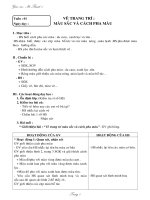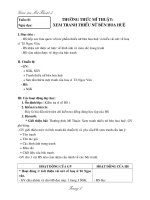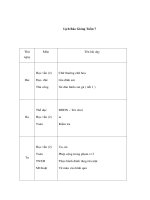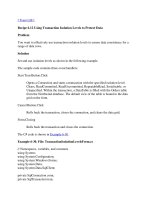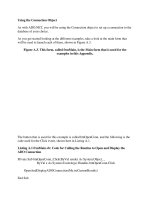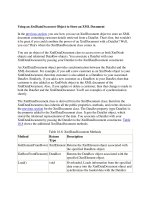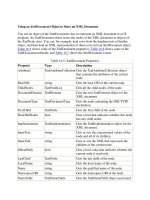Tài liệu Using an XmlDocument Object to Store an XML Document doc
Bạn đang xem bản rút gọn của tài liệu. Xem và tải ngay bản đầy đủ của tài liệu tại đây (39.5 KB, 8 trang )
Using an XmlDocument Object to Store an XML Document
You use an object of the XmlDocument class to represent an XML document in a C#
program. An XmlDocument object stores the nodes of the XML document in objects of
the XmlNode class. You can, for example, load rows from the database into a DataSet
object, and then load an XML representation of those rows into an XmlDocument object.
Table 16.5
shows some of the XmlDocument properties; Table 16.6 shows some of the
XmlDocument methods; and Table 16.7
shows the XmlDocument events.
Table 16.5: XmlDocument Properties
Property Type Description
Attributes XmlAttributeCollection Gets the XmlAttributeCollection object
that contains the attributes of the current
node.
BaseURI string Gets the base URI of the current node.
ChildNodes XmlNodeList Gets all the child nodes of the node.
DocumentElement XmlElement Gets the root XmlElement object for the
XML document.
DocumentType XmlDocumentType Gets the node containing the DOCTYPE
declaration.
FirstChild XmlNode Gets the first child of the node.
HasChildNodes bool Gets a bool that indicates whether this node
has any child nodes.
Implementation XmlImplementation Gets the XmlImplementation object for the
XML document.
InnerText string Gets or sets the concatenated values of the
node and all of its children.
InnerXml string Gets or sets the XML that represents the
children of the current node.
IsReadOnly bool Gets a bool value that indicates whether the
current node is read-only.
LastChild XmlNode Gets the last child of the node.
LocalName string Gets the local name of the node.
Name string Gets the qualified name of the node.
NamespaceURI string Gets the namespace URI of the node.
NameTable XmlNameTable Gets the XmlNameTable object associated
Table 16.5: XmlDocument Properties
Property Type Description
with the XML implementation.
NextSibling XmlNode Gets the node immediately following the
current node.
NodeType XmlNodeType Gets the type of the current node.
OuterXml string Gets the XML that represents the current
node and all of its children.
OwnerDocument XmlDocument Gets the XmlDocument object that the
current node belongs to.
ParentNode XmlNode Gets the parent of the current node.
Prefix string Gets or sets the namespace prefix of the
current node.
PreserveWhitespace bool Gets or sets a bool value that indicates
whether white space is to be preserved
when XML is loaded or saved. The default
is false.
PreviousSibling XmlNode Gets the node immediately preceding the
current node.
Value string Gets or sets the value of the current node.
XmlResolver XmlResolver Sets the XmlResolver object to use for
resolving external resources.
Table 16.6: XmlDocument Methods
Method Return Type Description
AppendChild() XmlNode Adds the specified node to the end
of child nodes.
CloneNode() XmlNode Creates a duplicate of the node.
CreateAttribute() XmlAttribute Creates an XmlAttribute object of
the specified name.
CreateCDataSection() XmlCDataSection Creates an XmlCDataSection
object with the specified data.
CreateComment() XmlComment Creates an XmlComment object
with the specified data.
CreateDocumentFragment() XmlDocumentFragment Creates an
XmlDocumentFragment object
with the specified data.
Table 16.6: XmlDocument Methods
Method Return Type Description
CreateDocumentType() XmlDocumentType Creates a new XmlDocumentType
object with the specified data.
CreateElement() XmlElement Overloaded. Creates an
XmlElement object.
CreateEntityReference() XmlEntityReference Creates an XmlEntityReference
object with the specified name.
CreateNavigator() XpathNavigator Creates an XpathNavigator object
that you can use to navigate the
XML document.
CreateNode() XmlNode Overloaded. Creates an XmlNode
object.
CreateTextNode() XmlText Creates an XmlText object with
the specified text.
CreateWhitespace() XmlWhitespace Creates an XmlWhitespace object.
CreateXmlDeclaration() XmlDeclaration Creates an XmlDeclaration object.
GetElementById() XmlElement Gets the XmlElement object with
the specified ID.
GetElementsByTagName() XmlNodeList Overloaded. Returns an
XmlNodeList object that contains
a list of all descendant elements
that match the specified name.
GetNamespaceOfPrefix() string Looks up the closest xmlns
declaration with the specified
prefix that is in scope for the
current node, and then returns the
namespace URI.
GetPrefixOfNamespace() string Looks up the closest xmlns
declaration with the specified
namespace URI that is in scope for
the current node, and then returns
the prefix.
ImportNode() XmlNode Imports a node from another XML
document into the current XML
document.
InsertAfter() XmlNode Inserts the specified node
immediately after the specified
Table 16.6: XmlDocument Methods
Method Return Type Description
reference node.
InsertBefore() XmlNode Inserts the specified node
immediately before the specified
reference node.
Load() void Overloaded. Loads XML data into
your XmlDocument object.
LoadXml() void Loads the XML document from
the specified string into your
XmlDocument object.
PrependChild() XmlNode Adds the specified node to the
beginning of the child nodes.
ReadNode() XmlNode Creates an XmlNode object based
on the information in a specified
XmlReader object. Your
XmlReader must be positioned on
a node or attribute.
RemoveAll() void Removes all the children and
attributes of the current node.
RemoveChild() XmlNode Removes the specified child node.
ReplaceChild() XmlNode Replaces one child node with
another.
Save() void Overloaded. Saves the XML
document to the specified location.
SelectNodes() XmlNodeList Overloaded. Selects a list of nodes
matching the specified XPath
expression.
SelectSingleNode() XmlNode Overloaded. Selects the first
XmlNode that matches the
specified XPath expression.
WriteContentTo() void Saves all the children of the XML
document to the specified
XmlWriter object.
WriteTo() void Saves the XML document to the
specified XmlWriter object.
Table 16.7: XmlDocument Events
Event Event Handler Description
NodeChanging XmlNodeChangedEventHandler Fires before a value in a node is
changed.
NodeChanged XmlNodeChangedEventHandler Fires after a value in a node is
changed.
NodeInserting XmlNodeChangedEventHandler Fires before a node is inserted.
NodeInserted XmlNodeChangedEventHandler Fires after a node is inserted.
NodeRemoving XmlNodeChangedEventHandler Fires before a node is removed.
NodeRemoved XmlNodeChangedEventHandler Fires after a node is removed.
Listing 16.17 shows a program that illustrates the use of an XmlDocument object. This
program performs the following steps:
1. Creates a DataSet object named myDataSet and fills it with the top two rows from
the Customers table.
2. Creates an XmlDocument object named myXmlDocument, and then loads it with
the XML from myDataSet. You can use the GetXml() method to return the
customer rows in myDataSet as a string containing a complete XML document.
You can then use the output string from GetXml() as the input to the LoadXml()
method of myXmlDocument; this loads myXmlDocument with the XML
document containing the customer details.
3. Displays the XML in myXmlDocument using the Save() method, passing
Console.Out to the Save() method. This results in the XML document being
displayed on the screen.
4. Retrieves the XmlNode objects in myXmlDocument using the SelectNodes()
method, and then displays the text contained in the child nodes of each XmlNode
using the InnerText property. You pass an XPath expression to SelectNodes() to
retrieve the required nodes.
5. Retrieves the XmlNode for the ANATR customer using the SelectSingleNode()
method, and displays the text contained in the child nodes of this XmlNode. You
pass an XPath expression to SelectSingleNode() to retrieve the required node.
Listing 16.17: USINGXMLDOCUMENT.CS
/*
UsingXmlDocument.cs illustrates the use of an XmlDocument object
*/
using System;
using System.Data;
using System.Data.SqlClient;
using System.Xml;

